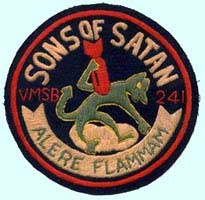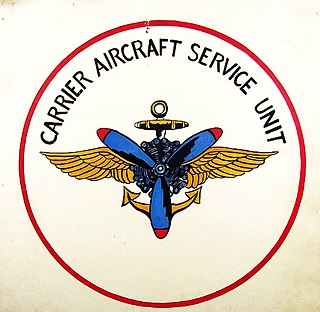
USS Bunker Hill was one of 24 Essex-class aircraft carriers built during World War II for the United States Navy. The ship was named for the Battle of Bunker Hill in the American Revolutionary War. Commissioned in May 1943 and sent to the Pacific Theater of Operations, the ship participated in battles in the Southwest Pacific, Central Pacific and the drive toward Japan through Iwo Jima and Okinawa, and air raids on the Japanese homeland.

The Grumman TBF Avenger is an American World War II-era torpedo bomber developed initially for the United States Navy and Marine Corps, and eventually used by several air and naval aviation services around the world.

The Douglas TBD Devastator was an American torpedo bomber of the United States Navy. Ordered in 1934, it first flew in 1935 and entered service in 1937. At that point, it was the most advanced aircraft flying for the Navy; however, by the time of the US entry into World War 2, the TBD was already outdated.

The Douglas SBD Dauntless is a World War II American naval scout plane and dive bomber that was manufactured by Douglas Aircraft from 1940 through 1944. The SBD was the United States Navy's main carrier-based scout/dive bomber from mid-1940 through mid-1944. The SBD was also flown by the United States Marine Corps, both from land air bases and aircraft carriers. The SBD is best remembered as the bomber that delivered the fatal blows to the Japanese carriers at the Battle of Midway in June 1942. The type earned its nickname "Slow But Deadly" during this period.

The Grumman F4F Wildcat is an American carrier-based fighter aircraft that entered service in 1940 with the United States Navy, and the British Royal Navy where it was initially known as the Martlet. First used by the British in the North Atlantic, the Wildcat was the only effective fighter available to the United States Navy and Marine Corps in the Pacific Theater during the early part of the Second World War. The disappointing Brewster Buffalo was withdrawn in favor of the Wildcat and replaced as aircraft became available.

The Grumman F6F Hellcat is an American carrier-based fighter aircraft of World War II. Designed to replace the earlier F4F Wildcat and to counter the Japanese Mitsubishi A6M Zero, it was the United States Navy's dominant fighter in the second half of the Pacific War. In gaining that role, it prevailed over its faster competitor, the Vought F4U Corsair, which initially had problems with visibility and carrier landings.

Alexander Vraciu was a United States Navy fighter ace, Navy Cross recipient, and Medal of Honor nominee during World War II. At the end of the war, Vraciu ranked fourth among the U.S. Navy's flying aces, with 19 enemy planes downed during flight and 21 destroyed on the ground. After the war, he served as a test pilot and was instrumental in forming the post-war Naval and Marine Air Reserve program. From 1956 to 1958 Vraciu led his own fighter squadron, VF-51, for twenty-two months. He retired from the U.S. Navy with the rank of commander on December 31, 1963. Vraciu later moved to Danville, California, and worked for Wells Fargo.
Fighter Squadron 11 or VF-11 was an aviation unit of the United States Navy. It was originally established as VF-5 on 1 February 1927, redesignated as VF-5S on 1 July 1927, redesignated as VF-5B in January 1928, redesignated VB-1B on 1 July 1928, redesignated VF-5B on 1 July 1930, redesignated VF-5S in July 1932, redesignated VF-5B in April 1933, redesignated VF-4 on 1 July 1937, redesignated VF-41 on 15 March 1941, redesignated VF-4 on 4 August 1943, redesignated VF-1A on 15 November 1946, redesignated VF-11 on 2 August 1948 and disestablished on 15 February 1959. It was the second US Navy squadron to be designated VF-11.

Eugene Anthony Valencia Jr. was a 3rd highest scoring United States Navy fighter ace in World War II with 23 claims.

Richard C. Mangrum was a United States Marine Corps lieutenant general who served as Assistant Commandant of the Marine Corps from 1965 to 1967. Mangrum was a Marine Corps aviator who was awarded the Navy Cross and the Distinguished Flying Cross for his actions during the Guadalcanal Campaign in World War II.

James D. "Jig Dog" Ramage was a Naval Aviator in World War II, the Korean War, the Vietnam War and the Cold War, and was a driving force in putting nuclear-capable attack aircraft aboard aircraft carriers. Before retirement he attained the rank of rear admiral.

A and T Recovery is an American company that has the primary purpose to locate and recover once lost World War II United States Navy aircraft for presentation to the American public. They have recovered nearly forty such aircraft, mainly from Lake Michigan. The aircraft were lost during the aircraft carrier qualification conducted out of the former Naval Air Station Glenview that was located north of Chicago, Illinois. The Navy had used two ships, the USS Wolverine (IX-64) and the USS Sable (IX-81), to qualify thousands of pilots.

On 20 November 1943, simultaneous landings were made by United States Marine Corps forces on Tarawa and United States Army forces on Makin, two coral atolls located in the Gilbert Islands chain in the South-Central Pacific.

Commander Hamilton McWhorter III was a United States Navy aviator and a flying ace of World War II, credited with shooting down twelve Japanese aircraft. He was the first Hellcat ace, first USN carrier-based double ace, and the first Grumman F6F Hellcat pilot to achieve double ace status. He flew 89 combat missions during World War II while flying with the VF-9 and VF-12 units. On May 23, 2014, he was also posthumously awarded the American Fighter Aces Congressional Gold Medal, when the United States Congress collectively awarded the gold medal to all flying aces: a navy pilot is depicted on the medal in the upper right.

Dean Samuel "Diz" Laird was the only U.S. Navy ace to have combat victories in both the Pacific and European theaters of World War II. He served in World War II, the Korean War, and the Vietnam War, and is given credit for 5.75 aerial victories. Laird flew 138 fighter missions during World War II. and was awarded the Distinguished Flying Cross and the Congressional Gold Medal, among other honors.

Marine Attack Squadron 241 (VMA-241) was an aircraft squadron of the United States Marine Corps, known as the "Sons of Satan". The squadron was commissioned during World War II and took part in the Battle of Midway, sustaining 75% losses. It was extensively involved in combat while providing close air support during the 1944–1945 Philippines Campaign. The squadron, equipped with A-4 Skyhawk light attack aircraft, became part of the Marine Forces Reserve, based at Naval Air Station Los Alamitos, California, from 1946 until the 1960s.

CptJames Francis Rigg from Saginaw, Michigan was a World War II Double Ace pilot who shot down eleven Japanese aircraft in the Pacific Theatre of World War II, including a Japanese Ace.

Dauntless: The Battle of Midway is a 2019 action film based on a true story of United States Navy aviators at the Battle of Midway. The theme of the film combines war and aviation film genres. The film was written, directed and produced by Mike Phillips. The screenplay of Dauntless: The Battle of Midway was written by Adam Klein and based on an original story by Phillips.

Carrier Aircraft Service Units (CASU) were United States Navy units formed during World War II for the Pacific War to support naval aircraft operations. From 1942 to 1946, 69 Carrier Aircraft Service Units were formed to repair and maintain aircraft. The first unit was deployed to Naval Station Pearl Harbor. The CASU-11, was deployed on January 22, 1943 at Naval Air Station San Diego. During the war the Navy lacked enough aircraft carriers to complete all the operational requirements.
















